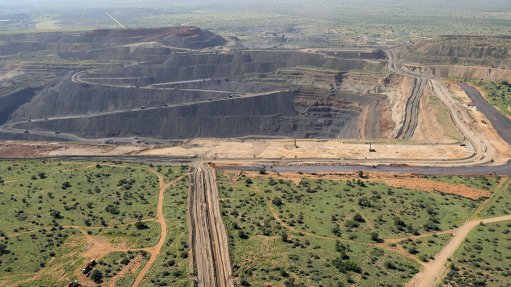
The Tshipi Borwa mine in South Africa's Northern Cape
ASX-listed Jupiter Mines reports that its 49.9%-owned subsidiary Tshipi é Ntle Manganese Mining recorded an increase in earnings before interest, taxes, depreciation and amortisation (Ebitda) to A$73-million for the quarter ended March 31 – the third quarter of Jupiter's current financial year – compared with Ebitda of A$33.5-million reported for the second quarter.
Net profit after tax also increased to A$50.2-million, from A$20.5-million in the second quarter.
Jupiter attributes the higher Ebitda and net profit to an increase in sales volumes and higher manganese prices.
Tshipi é Ntle Manganese Mining operates the Tshipi Borwa mine, in South Africa's Northern Cape. The mine produced 844 375 t of manganese in the third quarter, compared with the 808 532 t produced in the second quarter.
It sold 945 154 t of manganese in the third quarter, compared with 849 835 t in the second quarter.
The average cost, insurance and freight (CIF) price achieved for the quarter was $4.28 per dry metric tonne unit (dmtu), compared with $4.13/dmtu in the second quarter.
Jupiter notes that Tshipi sells most of its ore on a CIF basis. This accounted for 93% of tonnes sold in the third quarter, while 7% of ore was sold on a free-on-board (FOB) basis. The quarter included one FOB sale that was executed at an average price of $3.60/dmtu.
The average FOB price achieved in the second quarter was $2.97/dmtu.
Jupiter states that manganese ore prices at the beginning of the quarter were supported by increased liquidity in the portside market in China ahead of the Lunar New Year holiday, as well as a derailment on the Trans-Gabonese railway line which impacted bulk manganese ore exports from Gabon for several weeks.
"Shortly thereafter and during the second half of the quarter, manganese ore prices started to weaken as supply outstripped demand and manganese ore port stock levels in China remained elevated, pressurising prices further.
"Silicomanganese alloy prices have similarly followed a declining trend through the quarter, impacted by weak demand and high production costs, with some plants reducing or even ceasing production during the quarter," it adds.
Lacklustre downstream steel demand, particularly from the real estate sector in China, continues to weigh on sentiment in the short to medium term. On a long-term basis, however, global crude steel production is still forecast to increase through to 2027 which will lend support to manganese ore demand in the long term, Jupiter notes.